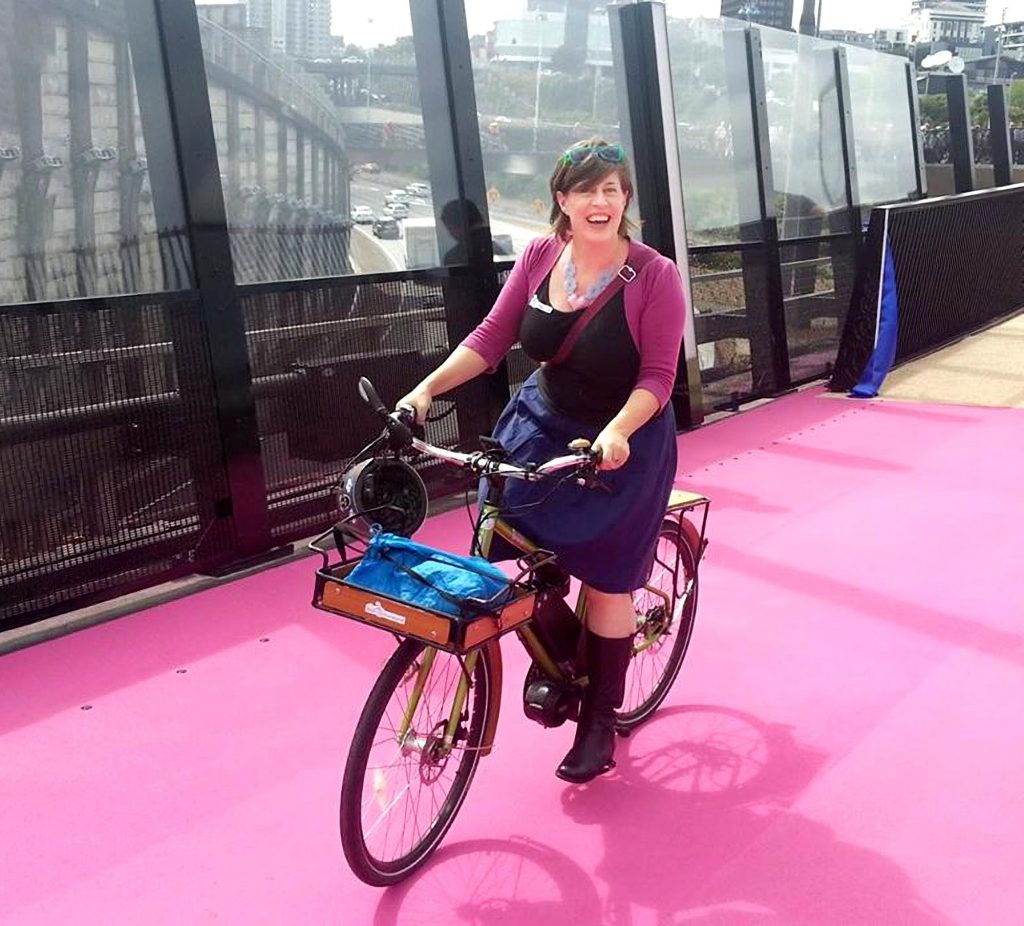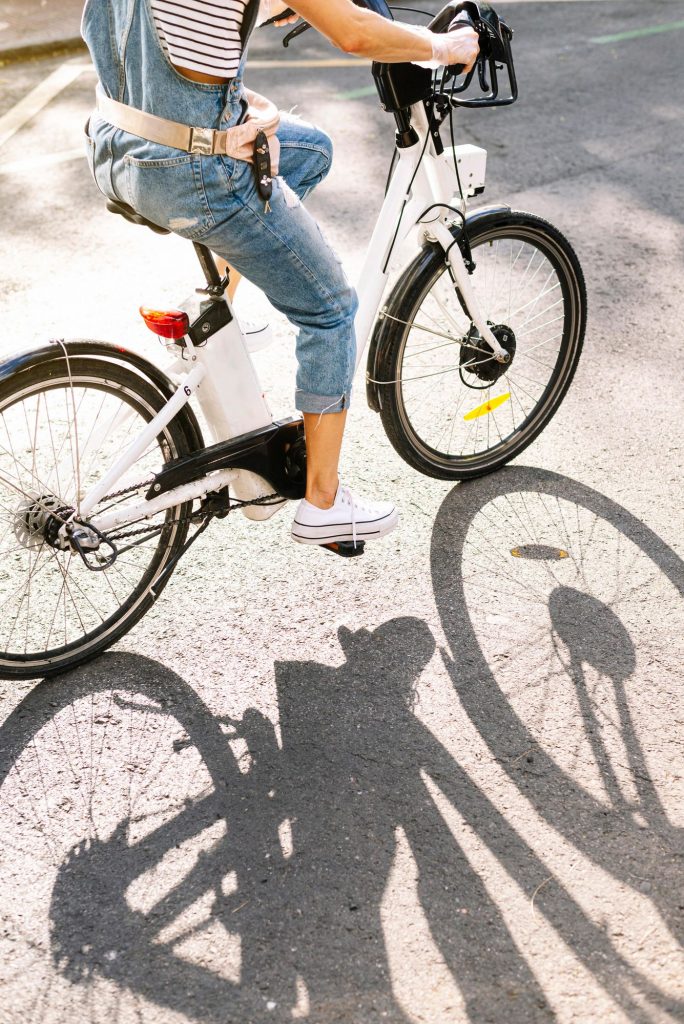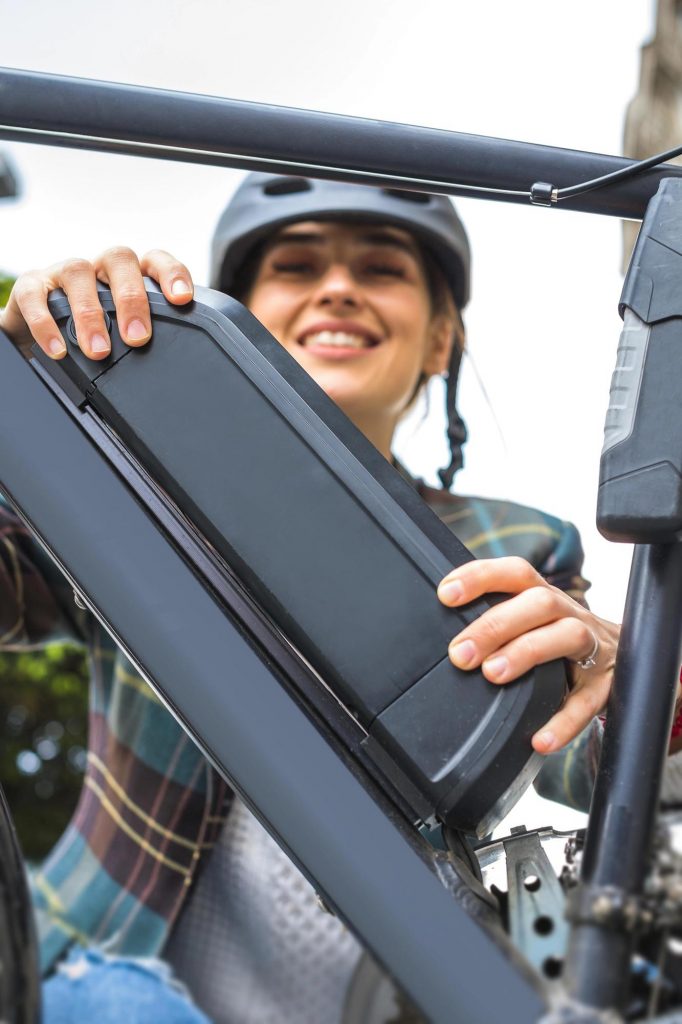Jolisa Gracewood pens a love letter to the electric bike, and the freedom and pleasure it affords us.
Ten years ago, I came home to New Zealand after cycling around the world. Not, I should clarify, in the way of those long-distance legends who circumnavigate the globe. Rather, everywhere I lived – and many places I visited – bikes were simply a handy way to get around.
Having biked to school in South Auckland, back when everyone did, and as a student in Christchurch (ditto), I was confident copying the locals wherever I went. I pedalled the back streets of Tokyo on a borrowed bike alongside little kids and nimble oldsters. I explored American college towns on rusty old 10-speeds.
I rode a CitiBike across the Brooklyn Bridge, just because. Another summer, I rented a bike in Copenhagen to keep up with the glamorous Danes, one of whom, in fake fur and heels, became an indelible bike-style icon. When babies arrived, I acquired a sturdy set of wheels fit for Connecticut snowstorms and the daycare run.
So I always assumed I’d jump straight back in the saddle on our return to New Zealand. Not so fast. The kids and I biked to school, the library, the shops. But in this city of cars, anything further afield felt daunting, especially if hills were involved. Aspiration, meet Auckland.

Then, one day I cycled to a job interview. On purpose. It was summertime, there were hills, and I arrived late, a literal hot mess. And I got the gig – working in advocacy, helping “normalise” everyday cycling for ordinary Aucklanders.
Perhaps showing up all earnest and sweaty- Betty helped me land the role. But I clung to the conviction that there had to be a way to recapture the effortless breeziness of biking that I’d enjoyed everywhere else.
Enter… the electric bicycle.
The American suffragist Susan B. Anthony famously said the bicycle did “more to emancipate women than anything else in the world”, and her New Zealand sisters likewise mobilised on wheels. I’d love to give these admirable ancestresses a go on an e-bike. Bloomers a-billowing, they’d adore this ultimate freedom machine.
In fact, if e-bikes didn’t exist, I reckon women would have had to invent them. Of course, powered bicycles have been around for ages – even our own Richard Pearse number-8-wired one, back in the day. But they’ve truly hit their stride in the past decade, becoming lighter, smarter and better- looking.
I’d had an initial taste when my gadget-fiend brother acquired an early specimen. He was evangelical; I was doubtful. When the power assist kicked in I panicked and the bike bucked like a bad pony. Not for me, I thought.
Then, thanks to the advocacy gig, I got the chance to test-ride a range of e-bikes. It was like being given the key to a stable of flying unicorns in different shapes, sizes and colours, and I couldn’t get enough.
Some had a front-wheel-hub motor, which pulls you up hills like an enthusiastic donkey. Others had the motor in the rear wheel, which felt like having an Olympic champ cranking away on the back seat of a tandem. The sweet spot, and my favourite: a mid-drive motor that powers through the pedals, making the most of your gears.

In every case, the magic was the same: hills lay down and headwinds vanished. I ate up the miles and kept going. Auckland became Amsterdam, if you squinted and ignored the traffic. Taking the hilly but quiet route became a viable option. As my friend Carol describes the e-bike advantage: where once a bike ride across the city required psyching yourself up, “Now I think: ‘Oh, I’ll just go there.’”
Above all, it was about ease: pedalling along while never running out of puff. It brought back the thrill of learning to ride, discovering you could propel yourself forward with a determined crank, tiny feet in seven-league boots. But this time round the encouraging parental hand at my back was invisible and battery-powered.
In other words, everything great about riding a bike, only more so. I fell in love with a bright green one with bamboo mudguards. I was sold.
I’m far from alone: New Zealand imports of new e-bikes and their zippy cousins, the electric scooters, are on track to outstrip imports of new cars. And for every electric car on our roads, there are already at least five electric two-wheelers. The EV revolution is quietly happening under our noses.

And it’s having an equalising effect. Maurice Wells, who’s been in the e-bike business for a decade, says women have always been a significant – and growing – part of his customer base. His shop, Electric Bike Team (off Auckland’s Karangahape Road next to the pink path, which makes for dreamy test-rides), is selling more and more e-bikes by the pair, especially to older couples keen to ride together.
The other thing, says Wells, is that while customers used to show up with questions about how e-bikes work, now the main source of intrigue is what you can do with them.
For starters, you can ride further than you might imagine. In 2018, Dr Kirsty Wild, of the University of Auckland, established that e-bikes easily tripled the distance people were willing to ride. She also found that among rush-hour cyclists on the city’s busy Northwestern bike path women made up 27% of all riders but 41% of e-cyclists. In other words, e-bikes don’t just flatten hills, they level the playing field.
But isn’t that, y’know, cheating? I heard this a lot in my early e-bike days, usually from jocular blokes on pedal bikes. Who knew riding into town was a race! And if it was, what was the prize? Not needing a shower and a change of clothes at the destination? In which case… I win.
Happily, you don’t hear that line so often now. But even if fitness was a major motivation – it’s not, I mainly like fresh air and wearing frocks – it turns out the average e-biker gets more exercise than their unplugged counterpart, thanks to riding further and more often… because it’s fun and easy. Which is to say, we all win.
Once you’ve converted to the electric dream, sooner or later the cargo cult beckons. The most recognisable cargo bikes have big boxes on the front for carting babies, dogs, or shopping. Then there’s the “longtail”, which is what I traded up to. With a padded rear seat and big panniers, mine was capable of hauling up to 100kg of kids, groceries or even a husband.
Suddenly I could do a whole weekly shop in one ride, the school run was more flexible, and my older offspring could bike to music lessons with guitar or saxophone on board. E-cargo bikes are versatile utility vehicles: couriers are cottoning on, pizza delivery fleets are flourishing, and tradies are learning a trick or two about “utes” that cost pennies to fuel and can squeeze into any parking spot.
Indeed, the e-mobility ecosystem grows more diverse by the day. The more you look, the more you see. I’ve become like a birdwatcher but for electric wheels. I see sturdy shopping trikes; mobility scooters and wheelchairs and specially adapted bikes; clever parent-child combos of all kinds.
Of course, the elephant in the room (and on the road) is traffic. For me, the most challenging part of every ride is the kilometre or so between my front door and the nearest separated bike lane. My options: run the gauntlet between parked cars and moving cars, or seek safety on the footpaths. Neither is ideal, and I’ve been shouted at in both cases.
It helps if we can see each other, literally and metaphorically. I once had words with a young driver who’d aggressively revved past me, only to meet again 50 metres up the road at the next red light. To my own surprise, the words that came out of my mouth were: “Hey bro, everything okay?” His face dropped. Disarmed, he apologised and said he had no idea why he’d done that. I wished him well, and off we went.
Word to the wise: these adrenaline-drenched conversations don’t often go as smoothly. One sticks in my mind: an SUV suddenly pulled out from a side street without looking. I hit the brakes, avoided a collision, and (of course) caught up with the driver at the lights. “You could have killed me back there,” I said, shaky and furious.
She wasn’t in the mood for my nonsense: she was in the middle of an urgent phone call, something about custody of her children. Which did sound stressful, to be fair. But so was the idea of my kids almost being orphaned by a moment’s inattention. We got nowhere, fast. The lights changed and off she drove, while I pulled over and cried in a bus shelter. I had met the enemy, and it was… myself, sort of? Just another mum on a mission.
So what’s the answer? Ultimately, we have to share the road. I don’t mean this as a well-meaning slogan, but as a constructive policy. Time to reshape our streets so they’re fairer, kinder, and easier on all of us. Remember in lockdown, when you could hear the birds and see for miles, and it became clear we have heaps of road space to play with?
Under all that traffic, there’s a perfectly decent network for walking, biking, scooting, skating… and reconnecting with each other. In these turbulent times, we deserve no less, our kids especially.
Thinking about the way ahead, I’m encouraged that Aotearoa’s climate action plan talks about reallocating street space, as a quick and affordable way to make the most of what we have. Smooth busways and bikeways make it easier for more of us to leave the car at home for short trips – and less traffic overall makes for nicer neighbourhoods. And electric mobility will be a vital part of this picture.
You might ask, can we afford to make this move at the scale we need, as fast as we need? With the climate clock ticking, the answer is: we can’t really afford not to.
While it’s true electric bikes cost more than their unpowered “acoustic” counterparts, they’re way less expensive than most cars, and more readily available. Fuelling up is where the cost really drops: it’s cheap as chips to charge up, so they pay for themselves pretty quickly.
The truly empowering prospect is getting these zippy vehicles into the hands of those whose lives will be most transformed by more affordable transport. Electric bikeshare and scooters are proliferating across our towns and cities, offering a taste of the future one ride at a time. But how to ensure even greater access to the e-revolution?
Government schemes to support e-bike purchases are increasingly popular overseas, and would make a huge difference here. There’s a busy secondhand market, too – look for the ones with one lady owner. And can we reprioritise some of the massive transport budget? For the cost of, say, one years-long motorway-widening project, you could buy everyone in Auckland an e-bike and change a million lives overnight.
Meanwhile, I’m back in the market for my next e-bike. My children grew as children do, so the lovely longtail is now in the hands of a friend and her overjoyed kid. This time, I’m after something elegant enough to evoke my travelling days, and sturdy enough to carry domestic necessities (or a passenger in a pinch).
Currently on my shortlist: the Cube Ella, the Linus Ember, and the aptly named eJoy from Benno. All cute, all well-specced, all capable of miles of adventure on a single charge. Supply chain issues are real right now, and she who hesitates finds herself waiting for the next container load, so I should make up my mind soon.
After all, wouldn’t it be ironic if the bike of my dreams was snapped up by someone else – say, another mum on a mission, looking for a fraction less friction in her everyday life? You know what: that’d be great, actually. More power to her! I have a feeling that’s how we all win.








